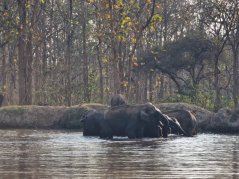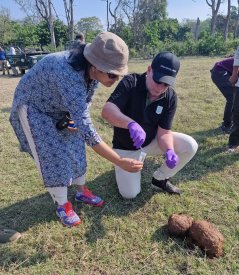
News
New genetic tool for Asian elephant conservation management
Wageningen University & Research and Blijdorp Zoo are developing a tool to uncover the DNA of Asian elephants in the wild. To this end, some researchers recently visited North India for the official kick-off of this new phase in the research project.
This study aims to better map and protect remaining elephant populations. The new tool will also be tested in the lab of our collaboration partner, the Wildlife Institute of India. According to geneticist Mirte Bosse of Wageningen University and Vrije Universiteit Amsterdam, the India meeting week has provided a basis for a great collaboration in the future. "As a conservation geneticist, it is a dream come true to be able to put my work of recent years into practice there," Bosse said.
Global interest
What started in 2021 with an NWO-funded PhD project at Wageningen University in collaboration with Blijdorp Zoo, gradually grew into a research and dataset that is being watched with interest worldwide. Especially in Southeast and South Asia, where Asian elephant numbers are rapidly declining. The total number is now estimated at around 40,000, but this has declined by more than 50 per cent in three generations. The largest wild population of 8,000 lives in India.
Unique DNA dataset through European zoos
As the European studbook keeper for the Asian elephant population in European zoos, Blijdorp has, in recent years - in collaboration with Wageningen University - been able to map the DNA of several Asian elephants from various Asian regions. Through blood sampling of the first generation of Asian elephants in European zoos, Blijdorp researcher and WUR PhD student Jeroen Kappelhof and research leader Mirte Bosse have been able to find special genetic markers that can be used to trace animals back to their geographical origins. It was the first time that these so-called SNPs (Single Nucleotide Polymorphism) have been identified in elephants from different countries, regions and populations. The result is a unique dataset.

DNA testing in wild elephants via dung samples
Since taking blood samples in the wild is virtually impossible and also undesirable, DNA testing in wild elephants will have to be done mainly on the basis of dung. Moreover, this method is easy and cheap to perform in a simple lab. "Researchers don't have to send their DNA to a fancy lab somewhere else," Mirte Bosse points out.
At the lab of the Wildlife Institute of India, the tool is being put into practice for the first time. Among other things, taking dung samples at different sites will reveal where the elephants living there come from, and how they are genetically linked.

Unfortunately, the quality of DNA taken from dung samples is much lower than that taken from blood. In contrast, the dataset of the Rotterdam and Wageningen researchers is based on blood samples and is therefore of high quality. Thanks to this quality and resolution, a tool can finally be developed to answer questions about wild populations using DNA from dung.
"With the information from the DNA of elephants in European zoos, we can now also gain more insight into the situation in the wild", Mirte Bosse says. "Such as how many animals from a certain subpopulation occurred in a certain area in the distant past. And whether inbreeding has occurred somewhere recently among Asian elephants. We can read all that from that DNA". Furthermore, the researchers hope to gain more insight into the use of existing corridors that connect fragmented areas, which in turn could give rise to even better protection of certain areas.
Implementation new method
In India, representatives of Blijdorp Zoo and Wageningen University personally met numerous wildlife organisations and researchers from surrounding countries who will also be using the method. The research team also jointly visited several North Indian wildlife parks. Dung samples will be tested from all Asian countries where elephants are still present. To implement the new method and overcome any teething problems, Blijdorp researcher Reeta Sharma will continue to supervise the project on the ground.